Chilli mangoes and ocean breeze
The sweetness of homecoming
The mesmerising orange dusk falling across the Arabian sea, and food stalls selling sweets and candy floss by the beach is an indelible Karachi memory.
Sizeable families bundled into vans travelling from afar for a Sunday night beach picnic, children screaming while rushing to the inviting water and their parents setting up the meal – each moment is relived as I stroll on that beach to this day. The silver sands blow that familiar gritty breeze through my hair and I think of family togetherness over food, fuelling a sense of belonging.
For me, living by the sea meant long walks on the beach lined with old wooden carts selling the forbidden pleasure gola ganda (shaved ice with sweet syrups), and breathing in the smells of spiced bhutta (corn on the cob) grilling on makeshift barbecues and the haunting wafts of seafood biryani that filled the air. My favourite snack, however, was the early summer kayri (raw mangoes), chopped and topped with a piquant mix of black salt and red chilli, leaving my senses heightened with each bite.
The simple combinations of Pakistani sweet snacks remind me of my homeland, where desserts don’t just end a meal but rejoice in life, childhood and its innocence, no matter what your age. The flavours in this chapter are the ones that speak most of the comfort of homecoming.
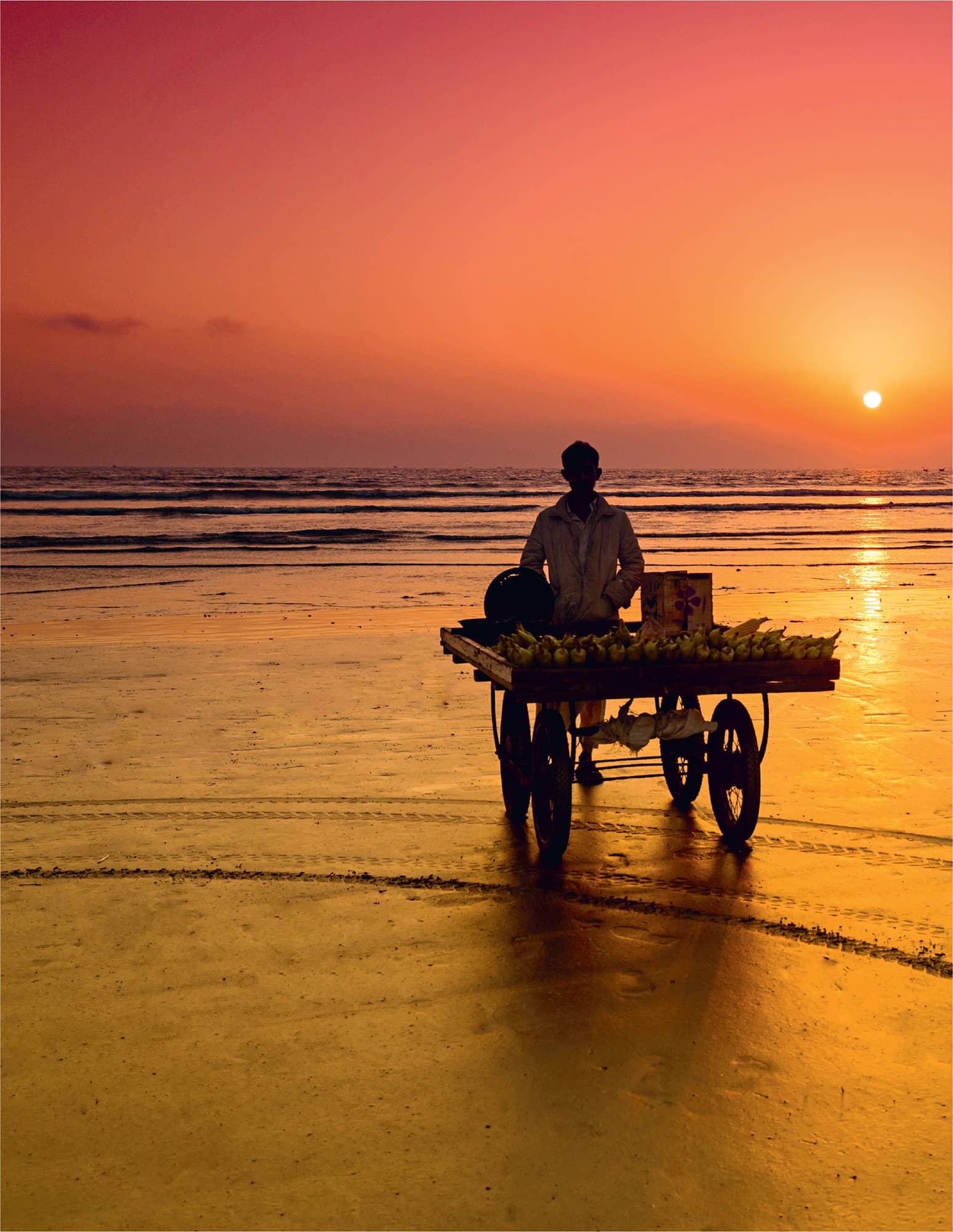
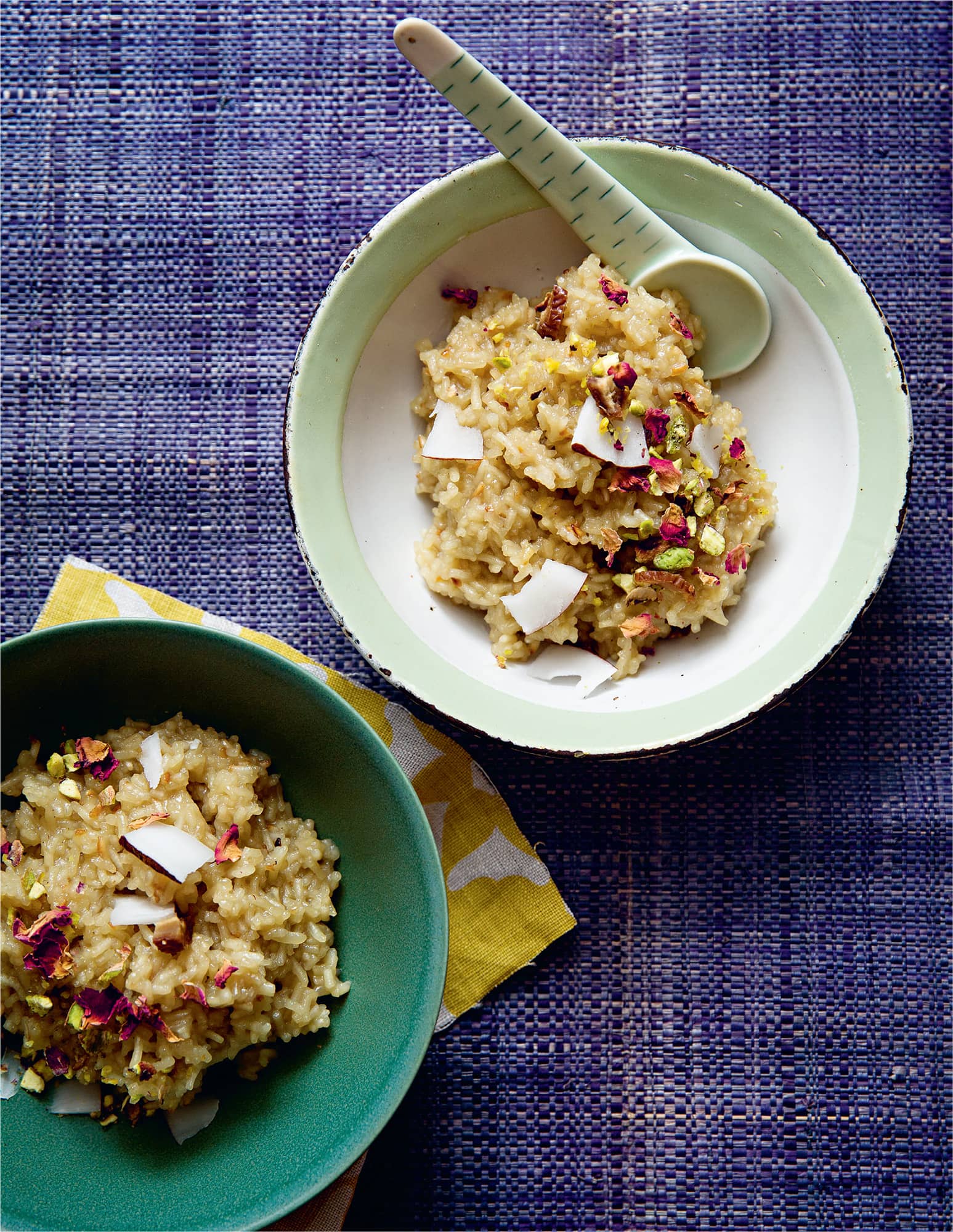
◁ Dadi’s rasyawal pudding
Cane sugar molasses rice pudding
This recipe was always a favourite of my fathers when he was growing up. His mum originally made it with raw sugar cane juice and young rice (she called it ‘naya chawwal’ or ‘new rice’). This is because traditionally this is a farmer’s dish, made at the time when sugar and rice are harvested from the fields. Since fresh sugar cane juice isn’t easy to find, I have substituted it (as do most people in my family) with a syrup made from jaggery (sugar cane molasses). If you can’t find jaggery then use muscovado sugar instead.
Preparation 20 minutes + overnight soaking | Cooking 45–50 minutes | Serves 4–6
100g/31/2 oz/1/2 cup basmati rice
250g/9 oz/2 cups jaggery, grated or muscovado sugar
250–300ml/9–10 fl oz/generous 1–11/4 cups water
Pakistani clotted cream / malai, to serve
To decorate
2 tbsp thinly sliced fresh coconut
1 tbsp slivered pistachios
1 tbsp dried rose petals
Rinse the rice, then allow it to soak in a bowl of water overnight. The next day, drain and set aside.
Place the jaggery in a heavy-based saucepan and pour in enough water to cover, then bring to the boil. As it boils, remove the scum that floats to the surface with a spoon and cook for 5–6 minutes until the jaggery has dissolved. Add the rice to the syrup and cook over a very low heat, stirring frequently and making sure that the rice doesn’t stick to the base of the pan. Keep cooking until all the water is absorbed and rice is cooked though and shiny. You may need to add more water if the rice is still raw. Continue to cook until the water has been absorbed.
Decorate with coconut, pistachios and rose petals, then serve warm with malai clotted cream.
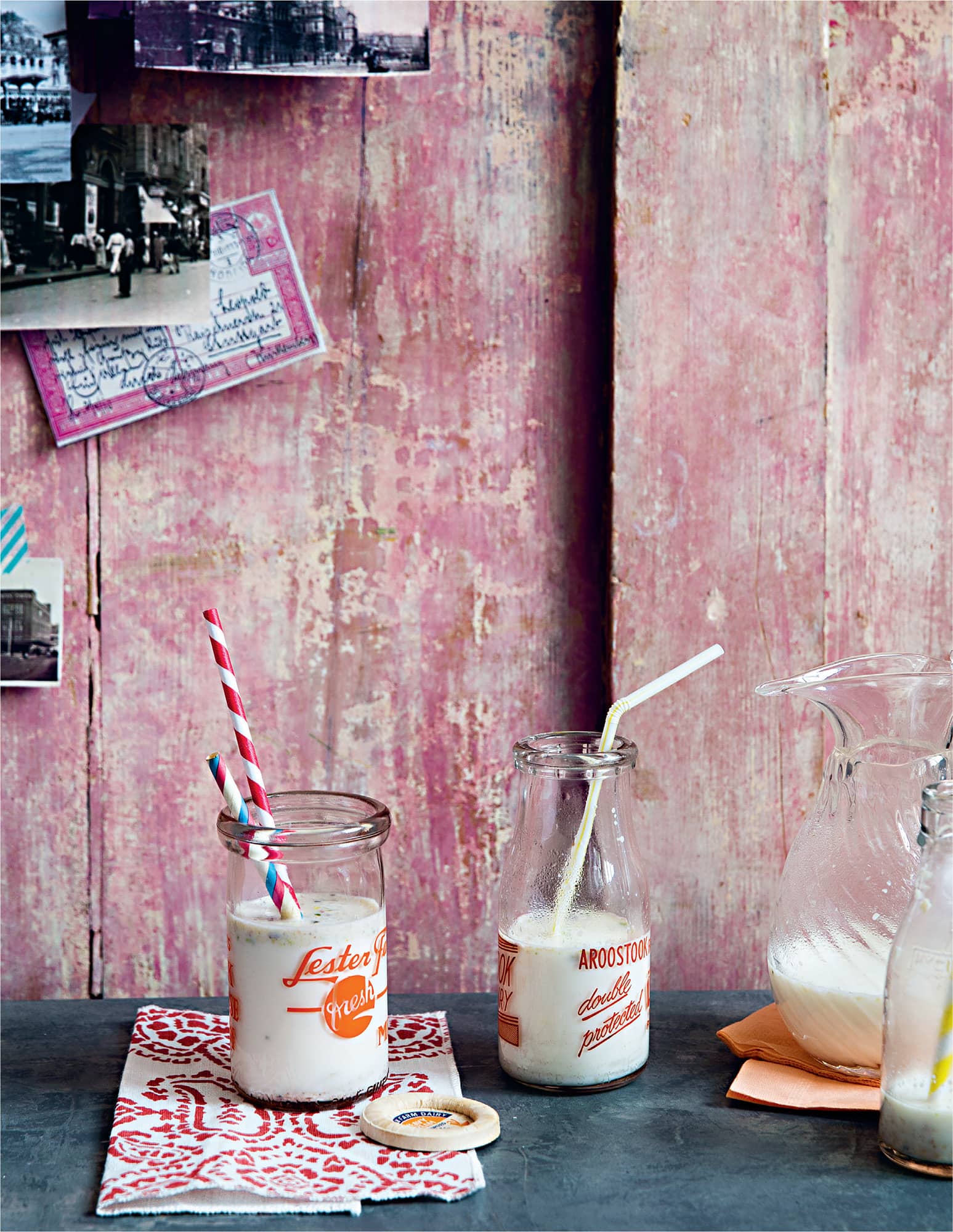
◁ Dooth ki bottel
Rich milk and rose water drink with spice, seeds and nuts
Fresh milk from the farmer’s shop is either delivered to your house each morning in a stainless-steel milk urn or bought from his farm shop. There was one treat that always enticed me to visit the milkman’s shop – an empty fizzy drink bottle filled with an ice-cold full-cream buffalo’s milk drink flavoured with a rich mix of pumpkin, poppy and sesame seeds, kewra and sugar. This recipe takes me right back to that indulgence.
Preparation 10 minutes | Cooking 15 minutes | Serves 5–6
600ml/20 fl oz/21/2 cups whole milk
1 tbsp white poppy seeds
1 tbsp ground melon seeds or pumpkin seeds
1/2 tbsp sesame seeds
1 tbsp crushed pistachios
1 tbsp crushed blanched almonds
2–3 cardamom pods, seeds removed and finely crushed
1 tsp rose water or kewra (screwpine extract)
2–3 tsp brown sugar
Heat the milk, seeds, nuts, cardamom and rose water or kewra together in a heavy-based saucepan. Add the sugar and stir to dissolve.
Once the sugar has dissolved, bring to the boil, then turn the heat down and simmer for 5 minutes.
Chill in the fridge and drink cold.
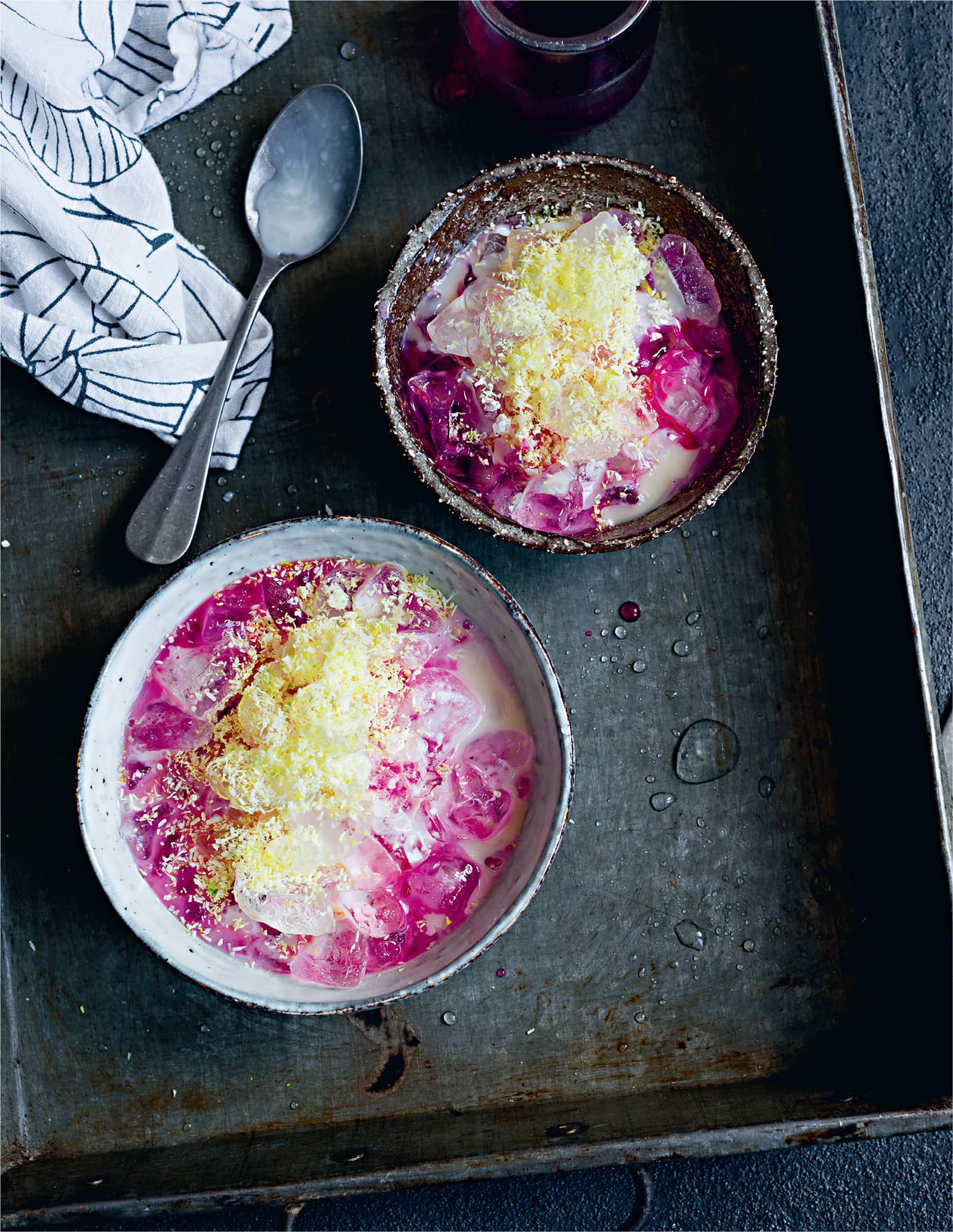
◁ Vimto gola ganda
Crushed ice topped with syrup
A summer day’s excitement when I was growing up involved rickety wooden carts laden with bright syrups and brick-sized blocks of ice, shaded under jute bags. The ubiquitous gola ganda was a cool respite from the unforgiving Pakistani sun. I loved the combination of shaved ice, topped with rose, Vimto or ice-cream soda syrups, and the most delectable part was lashings of condensed milk and desiccated coconut. This is my version of this jaw-achingly sweet childhood snack.
Preparation 10 minutes | Serves 2–4
15 ice cubes, crushed
2 tbsp condensed milk
2 tbsp rose syrup
2 tbsp vimto syrup
1 tbsp desiccated (dry unsweetened) coconut (can be dyed with gel food colour if desired)
Place the crushed ice in a bowl and add the condensed milk and all the syrups.
If you would like to colour the coconut, add a drop of a gel-based food colour to the coconut and mix until the coconut turns a different colour.
Top the ice with the desiccated coconut and serve immediately.
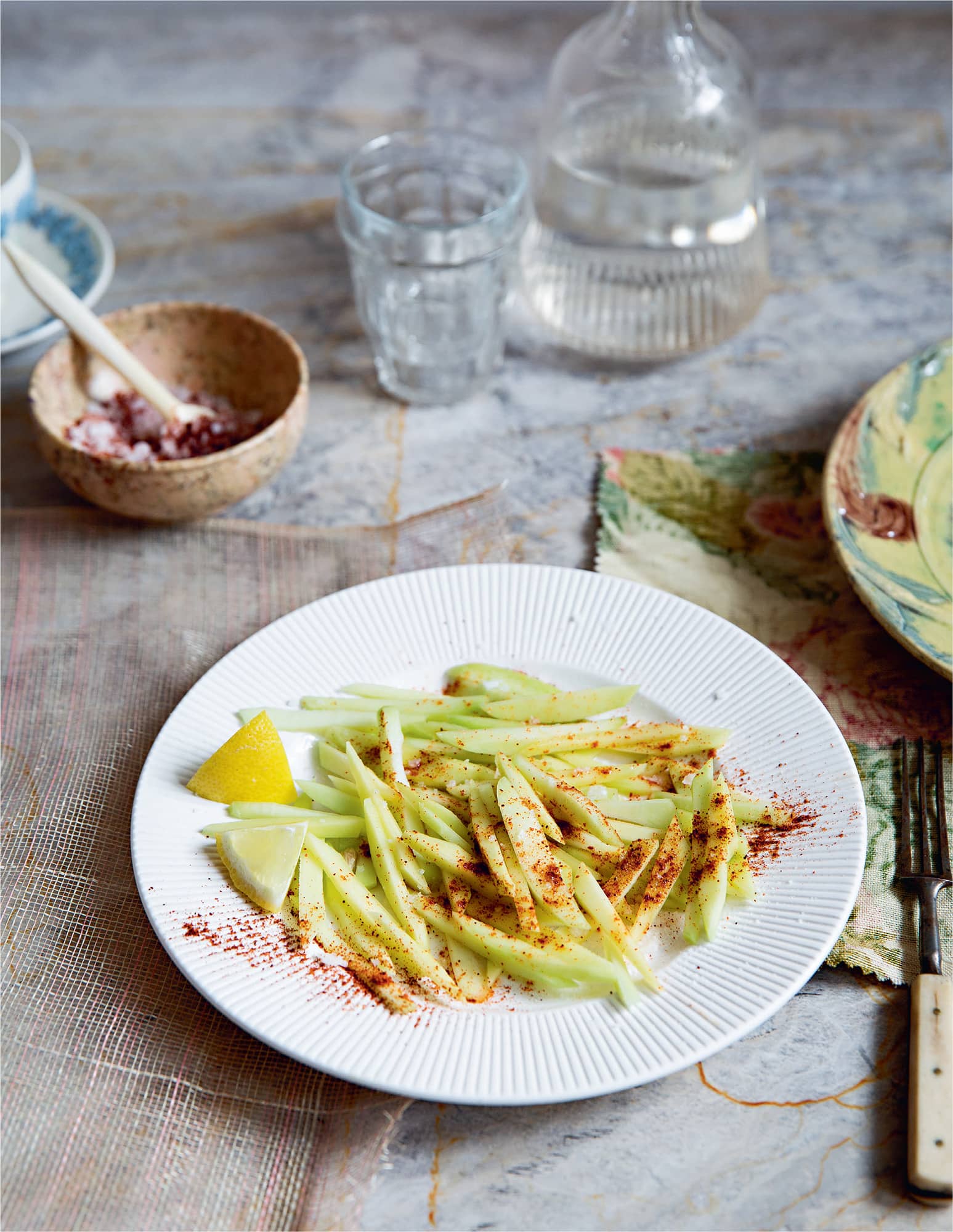
◁ Raw mango salad
with black salt, red chilli and lime
Just before Pakistani mango season, there would always be fruit stalls laden with small green raw mangoes. These sour fruits have a delicious taste when they are combined with complementary flavours. They can form the base for chutneys, jams and pickles, but I loved this simple snack of chopped raw mangoes spiced with a combination of red chilli, sea salt and a squeeze of lime or lemon.
Preparation 10 minutes | Serves 2
2–3 raw mangoes, peeled
1 tsp red chilli powder
1 tsp Himalayan black salt (kalanamak)
1/2 tsp unrefined caster (superfine) sugar
juice of 1/2 lime
Cut the mangoes into thin strips and discard the stones. Place the mango strips on a plate and add the red chilli flakes, salt, sugar and lemon or lime juice and toss together to combine.
Serve immediately.
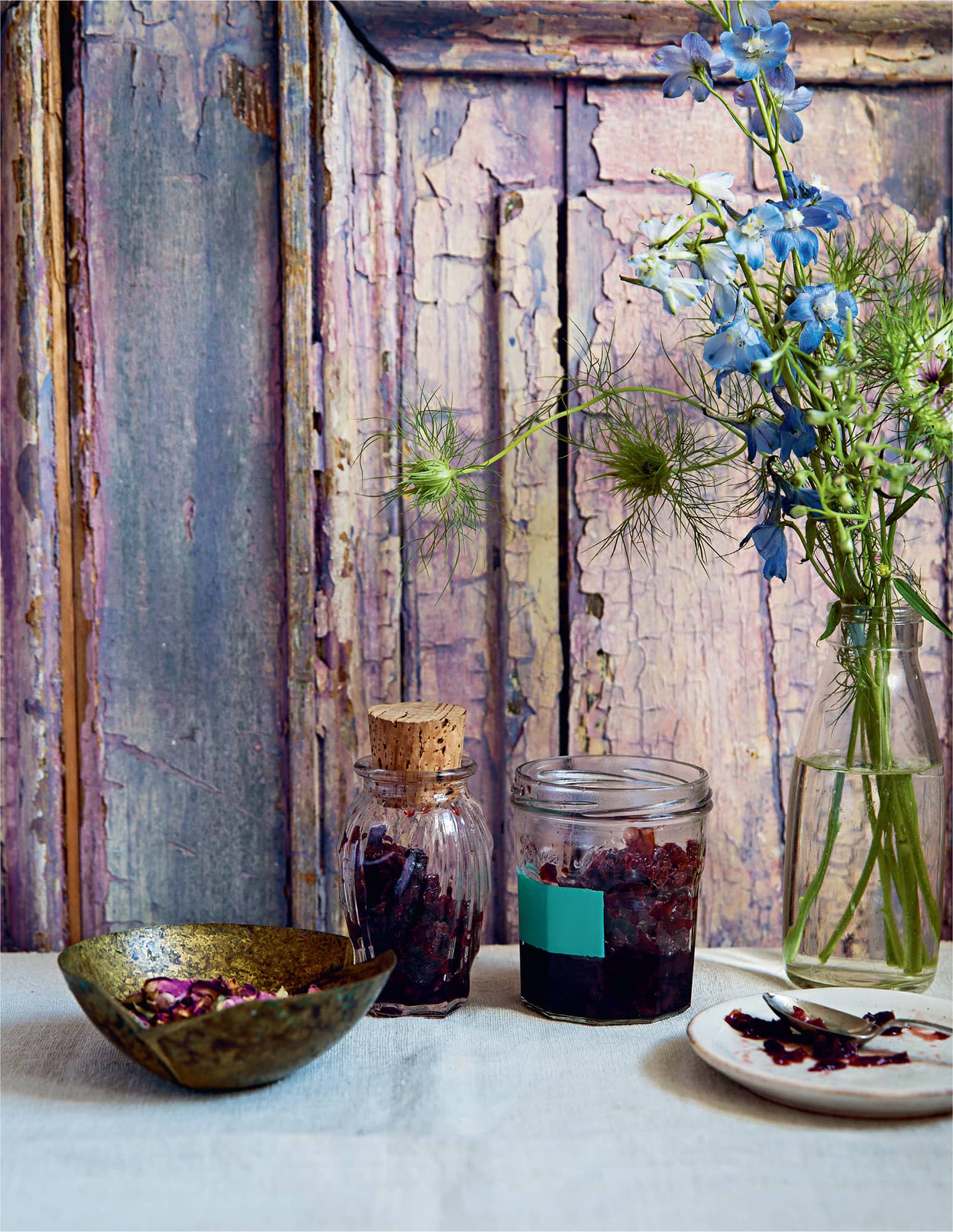
◁ Gulkand rose petal concentrate
Desi gulab are a local variety of oxblood roses that grow all year round in Pakistan. Adorning festival garlands and decadent desserts, these delicate petals are also used to make gulkand – a Pakistani rose petal jam with misri (rock sugar). My Nani (maternal grandmother) would pick roses from her garden, cook them slowly with misri, and we would then bottle them in an assortment of vintage glass jars. They were then left in the window to soak in the summer heat for a few weeks. Serve with pancakes or use as a filling in a plain Victoria sponge.
Preparation 15 minutes | Cooking 1 hour | Makes 1 x 300–400g/101/2–14-oz jar
350ml/12 fl oz/11/2 cups water (preferably filtered or spring)
55g/2 oz fresh rose petals (organic and pesticide free) or 40g/11/2 oz dried rose petals
400g/14 oz/2 cups cane sugar
3 tbsp lemon juice
1 tsp fruit pectin
Place the water and rose petals in a heavy-based saucepan and bring to a gentle simmer for about 10 minutes.
Add half the sugar and allow it to dissolve, then add the lemon juice. This will enhance the colour of the petals. Simmer for another 10 minutes.
Now mix the remaining sugar and pectin together in a bowl. Then, 1 teaspoon at a time, slowly and gently stir the pectin syrup into the petal mixture. This should make sure that it doesn’t clump together.
Simmer for another 15 minutes, stirring occasionally, until it is slightly thickened, but not as thick as jam since it sets once it is bottled.
Allow to cool slightly, then pour into a 300–400g/101/2–14-oz sterilised jar (see here) and leave to cool before sealing with a lid. Store in the fridge for 2 months. Use in cakes, pancakes, toast or rice pudding.
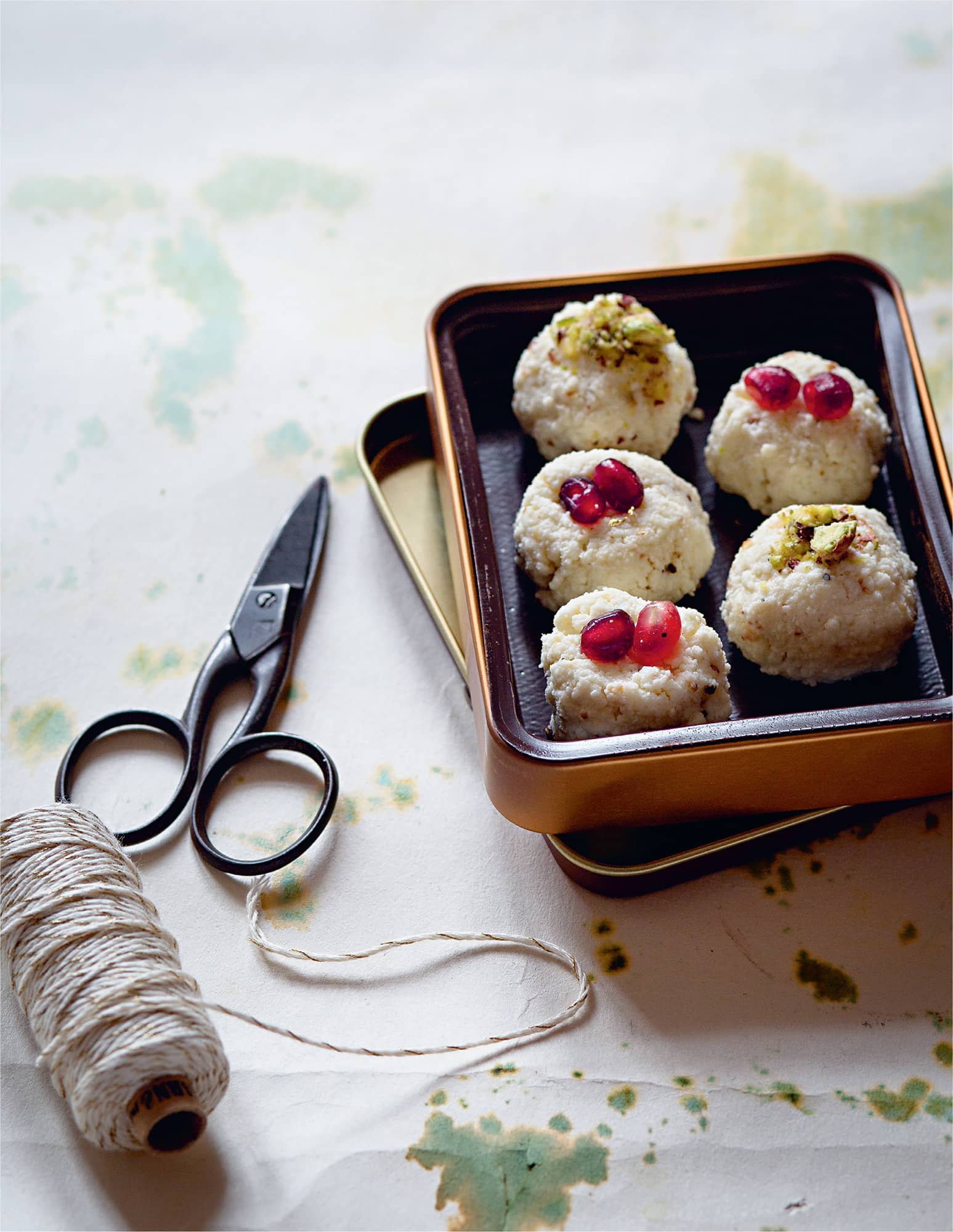
◁ My cousins’ mithai box
A shared treat of sweetened cottage cheese
My cousins (mother’s brother’s children) are half Bengali. Growing up I was close to them, and so many Bengali recipes have seeped into our kitchen, such as this mithai (sweetmeat), which is called sandesh. These treats are perfect for giving to friends and family, and this recipe is my gift to Sabrina, Natasha and Zain in memory of those carefree days in our grandmother’s home together.
Preparation 20 minutes | Cooking 10–15 minutes | Makes 6
115g/4 oz/1/2 cup homemade curd cheese
2 tbsp icing (confectioners’) sugar, plus extra for dusting
4–5 cardamom pods, seeds removed and ground or 1 tsp rose water
To decorate
6 slivered or ground pistachios
6 pomegranate seeds
Place the homemade cheese, icing sugar and cardamom or rose water in a non-stick saucepan, mix well and cook over a low heat. The cheese will begin to melt and become softer. Continue cooking for about 10 minutes, or until it begins to form a ball and starts to leave the sides of the pan. Take off the heat and allow to cool.
Dust the work surface lightly with icing sugar. Knead the cooled dough, then roll a piece into a golf ball-sized ball and flatten it with your hands. Repeat until all the dough is used up.
Decorate each ball with pistachios or pomegranate seeds. Chill in the fridge and eat within a day.

◁ Mummy’s panjeri semolina granola
with mixed nuts, dried fruit and puffed Arabic gum
This is made with a mix of fortifying ingredients that are said to nurse ill health, energise new mothers, and provide a filling breakfast. Both my grandmothers and mother used to make this frequently, and each recipe was slightly different. This is my version using lots of dried berries, fruits and a variety of nuts. It is wonderful served with Greek yogurt, over cereal or even on its own.
Preparation 15 minutes | Cooking 15 minutes | Serves 5–6
2–3 tbsp ghee
2 tsp Arabic gum crystals
3–4 cardamom pods, seeds removed and ground
1 tbsp roughly chopped pistachios
1 tbsp roughly chopped almonds or pecans
1 tbsp roughly chopped walnuts
1 tbsp pumpkin seeds
1 tbsp raisins
2 tbsp chopped dried apricots
1 tbsp dried blueberries or cherries
1 tbsp dried cranberries
150g/51/2 oz/scant 1 cup coarse semolina
1–2 tbsp thinly sliced fresh coconut
50g/13/4 oz/1/4 cup caster (superfine) sugar
Heat 1 tablespoon of the ghee in a saucepan or frying pan over a medium heat. Carefully add the Arabic gum crystals and allow to puff up, about 1–2 minutes. Once puffed up, place on a piece of kitchen paper. Set aside.
Add the remaining ghee to the pan, reduce the heat to low, then toss in the cardamom, and all the nuts, seeds and dried fruit, and stir-fry for 3 minutes.
Add the semolina and fry for 5 minutes, mixing it in with all the nuts, fruit and coconut. Keep the heat on low and do not let the semolina burn on the base of the pan. The colour of the semolina should start to darken slightly.
Now add the sugar and fry, stirring constantly for 1 minute. Do not let the sugar dissolve.
Turn off the heat, allow the panjeri to cool, then serve or store in an airtight container for up to 3 days.

◁ Pistachio chickie & Sesame rewri
Pistachio brittle & Sesame taffy
Winter dried fruit stalls heavily laden with pistachios, walnuts and pine nuts grown in the north of Pakistan would be the first sign of the changing weather. They were run mostly by Pathan men who had tiny fuel lamps that had smoke constantly billowing from them to attract the attention of passers-by (and of course keep the nuts warm). Along with nuts, they always had these two sweets, pistachio chickie (brittle) and sesame rewri (taffy), which were always very tempting.
Preparation 25 minutes + 35 minutes | Cooking 20 minutes | Serves 5–6
For the pistachio chickie
1 tsp ghee, plus extra for greasing
200g/7 oz/11/4 cup jaggery, grated
2 tbsp water
250g/9 oz/2 cups unsalted pistachios
3–4 cardamom pods, seeds removed and ground
1 tbsp dried rose petals
For the sesame rewri
70g/21/2 oz/1/2 cup sesame seeds
350ml/12 fl oz/11/2 cups water
1/2 tsp salt
540g/1 lb 3 oz/3 cups caster (superfine) sugar
500g/1 lb 2 oz/11/2 cups golden (light corn) syrup
3 tbsp ghee, plus extra for greasing
1 tbsp rose water
For the pistachio chickie
Line a baking tray with greaseproof paper and grease with butter or ghee. Combine the grated jaggery and water in a heavy-based saucepan and bring to the boil. Bring the temperature to 127°C (260°F) on a sugar thermometer. Add the nuts and ghee and heat to 143°C (289°F).
Add the cardamom and rose petals to the nuts and jaggery just before taking off the heat. Stir quickly and pour on to the prepared baking tray. Using a wooden spoon, spread and flatten the mixture to 5mm/1/4 inch thick. Allow to dry. Cut into squares and store in an airtight container for 1 week.
For the sesame rewri
Line a baking tray with greaseproof paper. Dry-roast the sesame seeds in a dry frying pan, then spread out on the prepared baking tray and cool. Put the water, salt, sugar and golden syrup in a heavy-based saucepan and heat over a medium heat. Do not stir and heat until the mixture reaches triple thread stage 127°C (260°F) on a sugar thermometer (see here). Add the ghee and rose water, then turn off the heat, leaving the thermometer in the pan and cool to 66°C (150°F).
Rub ghee on your hands and, picking up 3 tablespoons of the mixture at a time, pull and fold the mixture repeatedly until it turns a creamy white. Taking a 10cm/4-inch long piece, pull the candy until it is 5mm/1/4 inch thick, then cut into 1cm/1/2-inch pieces, toss in the roasted sesame seeds and place on a sheet of greaseproof paper to dry.
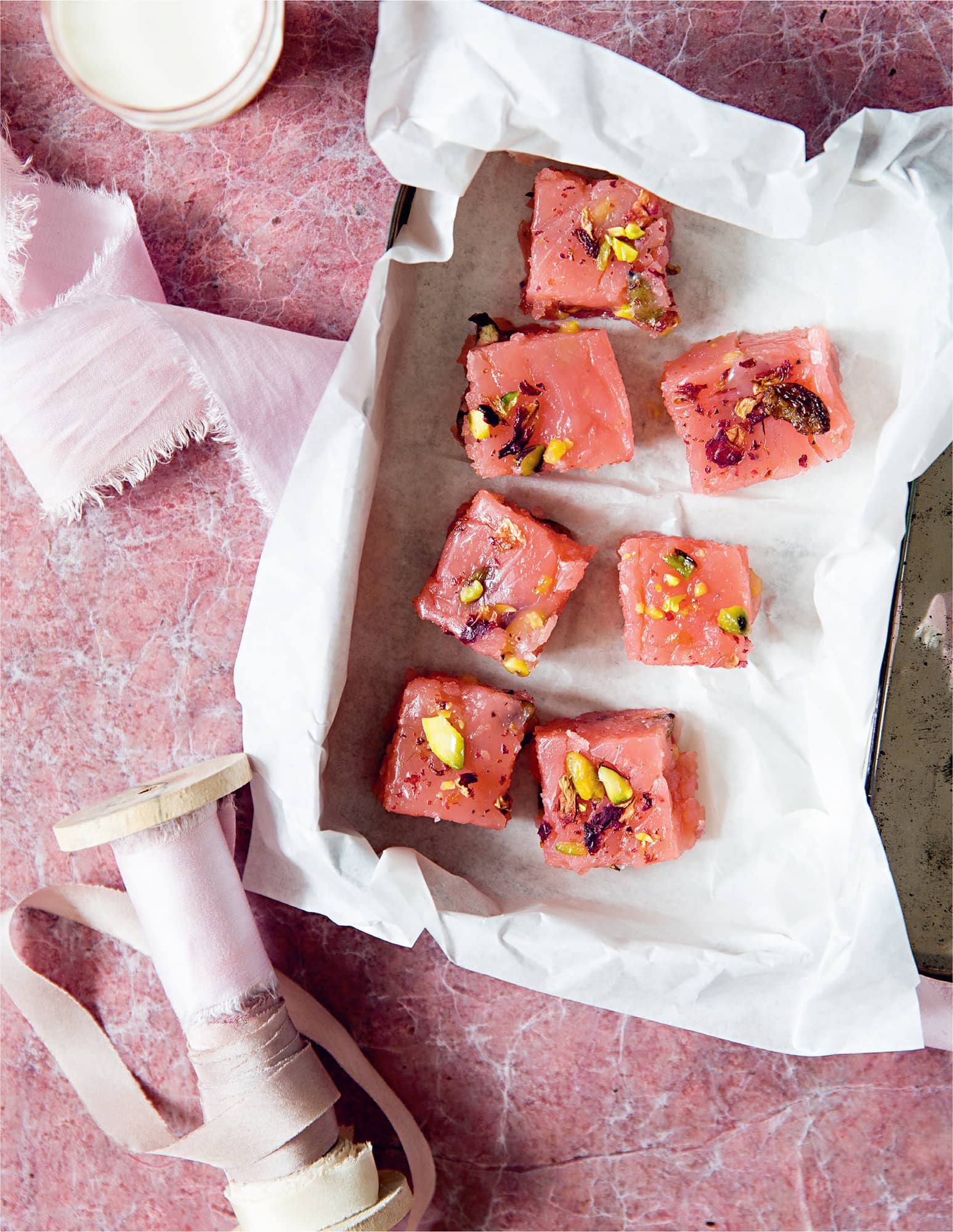
◁ Karachi halva
with pumpkin seeds and cashews
This Turkish delight-like sweet was invented in my home town. As a child I would pass by mithai (sweetmeat) shops and look longingly at the many vibrant, colourful sweets on offer. There was one sweet that always caught my eye – orange, green or pink chewy, rubber-like shiny halva cut into neat squares and topped with nuts and pumpkin seeds. Magical.
Preparation 20 minutes + 1 hour cooling | Cooking 30–40 minutes | Makes 6–10
50g/13/4 oz/1/2 cup cornflour (cornstarch)
590ml/20 fl oz/21/2 cups water
1/4 tsp pink gel food colour
2 tbsp ghee, plus extra for greasing
11/2 tbsp chopped cashews
1 tbsp pumpkin seeds
300g/101/2 oz/11/2 cups caster (superfine) sugar
3–4 cardamom pods, seeds removed and ground
To decorate
1 tbsp dried rose petals
1 tbsp slivered pistachios
1 tbsp raisins
Place the cornflour in a bowl, add 350ml/12 fl oz/11/2 cups water and mix until smooth. Add the food colour, stir and mix well, then set aside.
Grease a large plate with ghee and set aside.
Heat 1 tablespoon of the ghee in a wok-style pan over a medium heat, add the cashews and pumpkin seeds and roast for 30 seconds, or until golden brown. Set aside.
In the same pan, add the sugar and 240ml/8 fl oz/1 cup water and heat over a medium heat to allow the sugar to dissolve. Slowly add the cornflour mixture, stirring constantly.
Now turn the heat down very low and keep stirring, the mixture will start turning glossy and coming together. It will thicken slowly, but don’t stop stirring otherwise lumps will form.
Now add the remaining ghee and the ground cardamom and mix well. The mixture should be very thick by now. When the halva starts to leave the sides of the pan and becomes very shiny, add the roasted nuts and seeds. Turn off the heat and stir. The ghee should start coming to the surface. Transfer the mixture to the greased plate and level it with the back of a spoon.
Allow to cool for at least 1 hour before cutting it into squares and decorating with rose petals, pistachios and raisins.
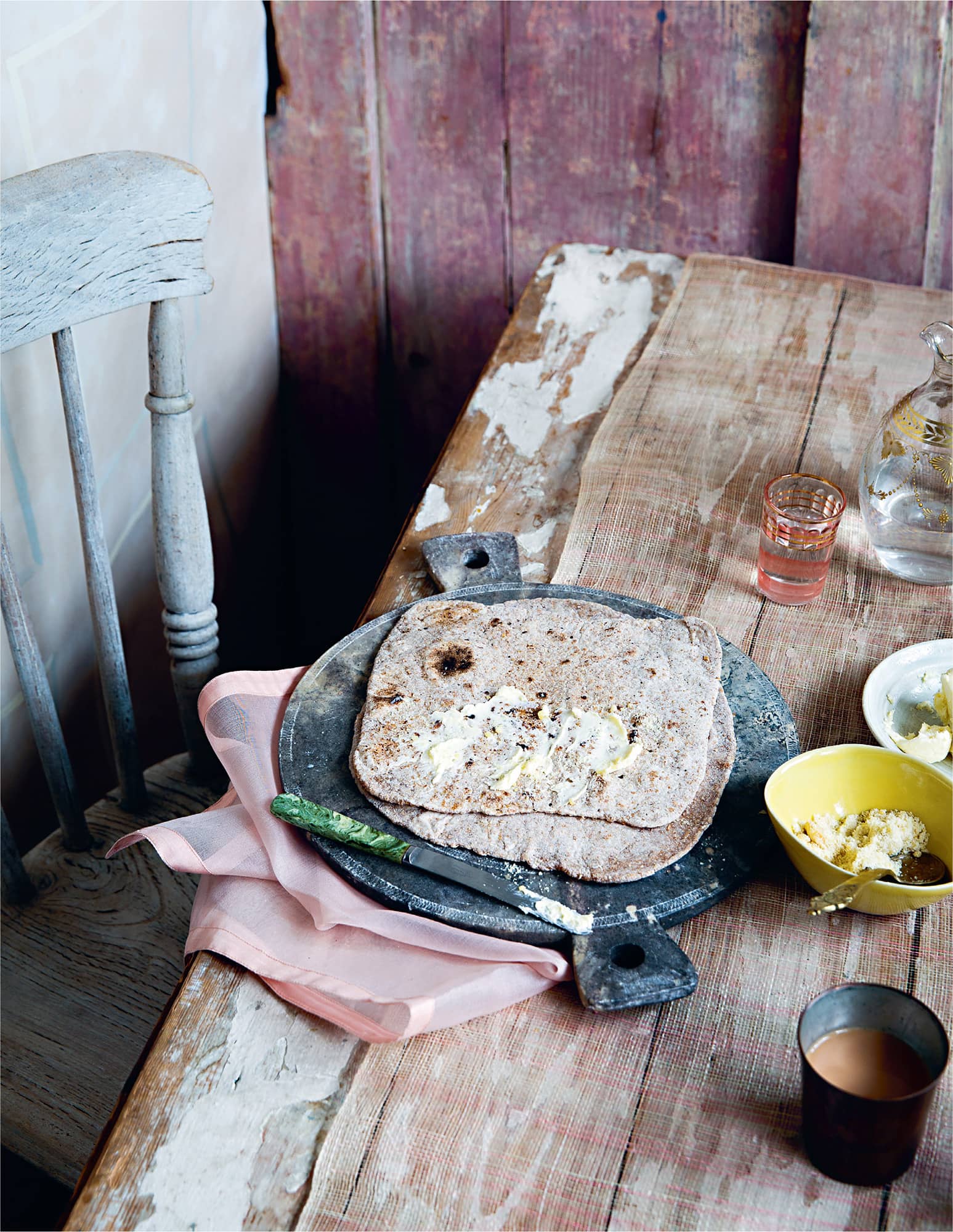
◁ Makhan roti cheeni
Chappatis rubbed with homemade butter and raw sugar
Sometimes the best treats are those made with love and leftovers. This is a simple combination of chappati topped with homemade butter and raw cane sugar, something my Nani (maternal grandmother) and my mother would give me as a snack or just because leftover bread needed eating. The comfort of those flavours still take me back to my childhood, I know my daughter Ayaana will come to love this as well, keeping my Pakistani heritage alive as she grows up in Scotland.
Preparation 30 minutes | Cooking 25 minutes | Makes 6–8
For the chappatis
135g/43/4 oz/scant 1 cup wholemeal (wholewheat) flour, plus extra for dusting
a pinch of salt
200ml/7 fl oz/scant 1 cup water
For the makhan
150ml/5 fl oz/2/3 cup thick double (heavy) cream
10–12 ice cubes
very cold water, as needed
a pinch of salt
2 tbsp raw cane sugar or caster (superfine) sugar
Begin by making the chappati dough. Mix the flour and salt together with enough of the water as needed to make a soft dough. Cover the dough with a damp tea towel and set aside at room temperature.
To make the makhan, put the cream and ice in a blender, add water, a little at a time, and blend until the cream starts to separate and you start to get butter floating to the top. Stop blending and collect the butter in a muslin cloth. Squeeze out all the liquid and set the butter aside on a plate in the fridge.
Now make the chappatis. Flour a clean work surface. Taking tennis ball-sized pieces of the dough, roll them out into round flatbreads with a rolling pin, until they are about 5mm/1/4 inch thick.
Heat a flat pancake pan or tawa over a medium heat. Place each chappati on the hot pan and press down using a tea towel from the corners, until the base is light brown, about 1 minute. Flip over and cook on the other side for 1–2 minutes, then remove from the pan and place in a foil pouch to keep warm.
To assemble, place a hot chappati on a plate, rub with the makhan and sprinkle with raw sugar, then roll up and eat immediately.